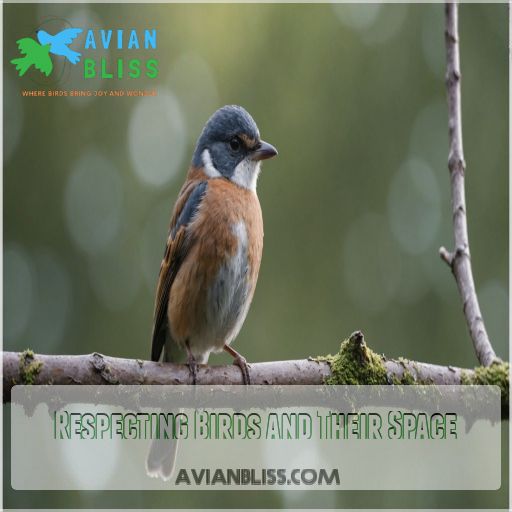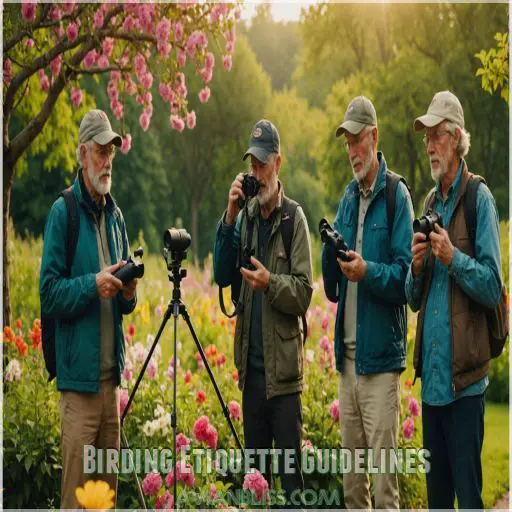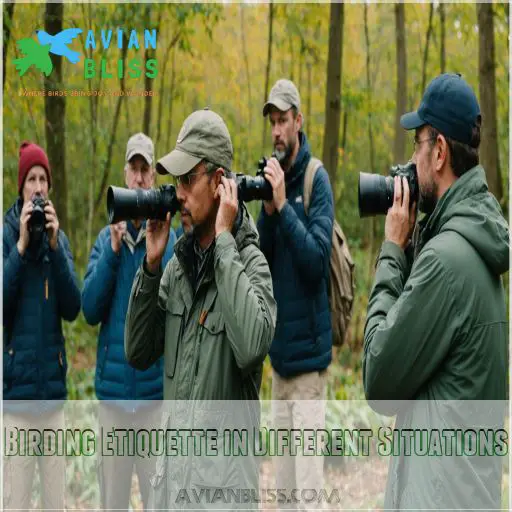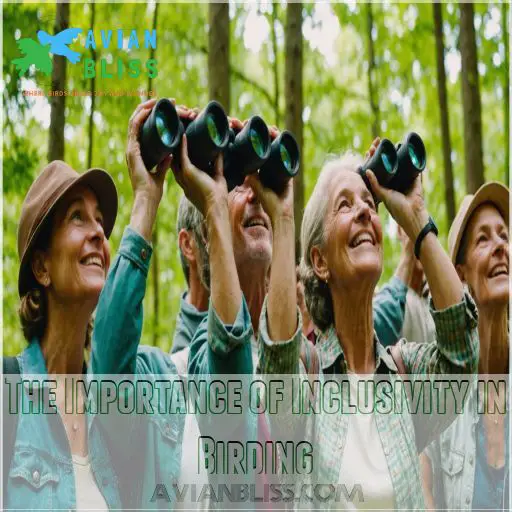This site is supported by our readers. We may earn a commission, at no cost to you, if you purchase through links.

Respect these feathered wonders by steering clear of nests and using recordings or green pointers sparingly—think of it as chivalry for birds.
Prioritize the well-being of rare species, sharing your sightings with conservationists.
Embrace your inner nature ninja and let the birds stay blissfully unaware of your presence, just like parents carefully shelter their young from the rain.
Ready to uncover the secrets of ethical birdwatching? There’s more to explore!
Table Of Contents
- Key Takeaways
- Respecting Birds and Their Space
- Birding Etiquette Guidelines
- Birding Etiquette in Different Situations
- The Importance of Inclusivity in Birding
- Best Practices for Birding Etiquette
- Frequently Asked Questions (FAQs)
- What are the five rules of birding ethics?
- What is the etiquette for birders?
- What colors not to wear when birding?
- What are the unethical practices in birdwatching?
- How to balance birdwatching with photography needs?
- What equipment is best for ethical birding?
- Can birdwatching contribute to conservation efforts?
- How to handle encountering aggressive birds in the wild?
- What tips help minimize noise while birding?
- Conclusion
Key Takeaways
- Blend In and Step Lightly: Think of yourself as a ninja in the birdwatching world. Stick to muted, earthy tones so you don’t give birds a neon surprise. Walk softly, like a dancer on tiptoes, and keep your chatter to whispers. Every step you take matters, and you’ll keep the birds calm while sharpening your skills.
- Respect Bird Real Estate: You’re a guest in their neighborhood, so don’t crash into their nests or flash them with bright lights like a celebrity paparazzo. Keep your distance and let them enjoy the day. Remember, rare birds are like precious gems – handle with utmost care.
- Share the Adventure: Birding is more fun with friends, so lend your spotting scope and help beginners as warmly as you’d offer hot cocoa on a cold day. Keep voices low like a gentle symphony and respect everyone’s space. It’s all about weaving a community where everyone can enjoy the beauty together.
- Be a Conservation Hero: Your birdwatching can help save the day. By sharing your sightings with conservationists, you’re contributing to efforts that protect these feathered wonders. It’s like being a secret agent for Mother Nature, ensuring our bird buddies are safe and sound for future generations.
Respecting Birds and Their Space
When you’re out birding, it’s all about respecting the birds and their space, even if they can’t send you an eviction notice for getting too close.
Keep your distance and wear your best camouflaged garb while practicing the birding version of "silent running,"
as your efforts can make a world of difference for our feathered friends.
Avoiding Disturbance and Stress
Avoid invading a bird’s territory if it seems agitated. Never disturb a bird sitting on its nest – this highly stresses them. Stay quiet, avoid bright clothing, and use green pointers cautiously to prevent scaring birds.
- Avoid chasing or entering a bird’s territory if it shows signs of agitation, such as fleeing or giving an alarm call.
- Don’t disturb a bird sitting on its nest, as it will become highly stressed.
- Wear neutral clothing: Some birds are sensitive to bright colors, so avoid wearing flashy clothing.
- Use green pointers with caution, ensuring a safe distance from the bird.
- Be especially respectful of rare or endangered species, as these are highly sensitive to disturbance.
Minimizing Noise and Foot Traffic
Using Recordings and Pointers Responsibly
Minimizing Noise and Foot Traffic
Stepping lightly—like a feather floating on the breeze—helps to keep the birds at ease. Your quiet birding approach minimizes noise pollution and footprint impact. Remember, every whisper counts in respecting bird sensitivity and practicing trail etiquette during your outdoor recreation.
Your quiet birding approach minimizes noise pollution and footprint impact.
| Action | Benefit |
|---|---|
| Walk softly | Reduce noise pollution |
| Whisper if needed | Respect bird sensitivity |
| Follow trail etiquette | Protect wildlife habitats like the marshes and wetlands where whooping cranes thrive. Protect wildlife habitats |
| Limit group size | Decrease footprint impact |
| Share spotting scope | Foster community understanding |
Using Recordings and Pointers Responsibly
After quiet footsteps, focusing on responsible birdwatching tools makes exploring more fun. Bird call ethics matter!
- Limit playback impact.
- Prioritize recording etiquette.
- Make sure pointer safety.
- Keep green pointer use minimal.
- Enhance your experience without stressing birds. Enjoy those melodies!
Wearing Neutral Clothing and Colors
Blend in with nature like a secret agent on a bird-watching mission—go for neutral colors.
Camouflage is key!
Flashy clothing is like a neon sign to birds, so opt for subtle clothing choices and observe bird behavior without startling them.
Observe bird behavior without startling them.
Protecting Rare and Endangered Species
Rare and endangered birds are highly sensitive – even slight disturbances can harm their populations. Tread lightly, keep your distance, and avoid playbacks or flash photography. Protect these precious species by respecting their space.
- Minimize noise and activity
- Avoid approaching nests
- Report any sightings to conservation groups
Birding Etiquette Guidelines
When you’re out birding, following good etiquette helps you enhance your own experience and makes sure you don’t ruffle any feathers—literally or metaphorically!
By focusing on bird-oriented, habitat-oriented, and people-oriented etiquette, along with mindful photography practices, you can contribute positively to both the environment and the birding community.
Bird-Oriented Etiquette
You’ve learned the ropes on respecting birds and their space.
Now, let’s talk etiquette!
While bird-watching, nest safety is your top priority.
Birds aren’t just pretty: they need peace, too.
Avoid stressing them with loud noises or excessive bird calls.
Habitat-Oriented Etiquette
When birding, think of habitat as the guest room you’re borrowing from nature.
Follow these guidelines for bird-friendly behavior:
- Stay on paths to lessen impact.
- Avoid trampling vegetation; it’s not a dance floor!
- Respect habitat boundaries.
- leave no trace.
People-Oriented Etiquette
When birding with others, keep your voice down and be mindful of others’ space. Form a line to take turns at the spotting scope, and lend a hand to beginner birders. Respect private property and stay on designated trails. Birding is a shared experience – let’s make it an inclusive one!
Keep Voices Down to minimize disturbance to birds and wildlife.
Be Aware of Others to allow everyone to enjoy the view.
Assist Beginners to foster a welcoming environment.
Respect Boundaries to protect habitats and follow rules.
| Etiquette Guideline | Why It Matters |
|---|---|
| Keep Voices Down | Minimize disturbance to birds and wildlife |
| Be Aware of Others | Allow everyone to enjoy the view |
| Assist Beginners | Foster a welcoming environment |
| Respect Boundaries | Protect habitats and follow rules |
| Collaborate Kindly | Enhance the birding experience for all |
Etiquette for Photography and Recordings
Let’s snap those bird photos like pros! For ethical bird photography and recording:
- Minimize movement—animals aren’t paparazzi fans.
- Skip the flash; it’s not a red carpet.
For ethical sound recording:
- Use unobtrusive microphones—no booms in nests!
- Limit playback; birds don’t need encores.
Birding Etiquette in Different Situations
Birding etiquette can differ based on where you are, so it’s key to stay aware of your surroundings.
Whether you’re moving through crowded birding trails or sensitive habitats, remembering to keep a safe distance from birds, respecting closures, and managing pets can help everyone enjoy a harmonious birdwatching experience.
Keeping a Safe Distance From Birds
Some say good things come to those who wait—well, in bird-watching, patience is your best friend.
Keep a respectful distance to understand bird behavior.
Observe those nesting birds from afar; close encounters may ruffle feathers, literally!
Happy wildlife viewing!
Observing Trail and Area Closures
Keeping a safe distance? You’re already on the right track! Now, embrace closures.
Those signs aren’t just decoration—they’re bird life-savers!
Stick to trails, respect signs, and avoid sensitive nesting regions:
- Shield fragile habitats.
- Honor nature’s "Do Not Disturb" requests.
- Support vulnerable species.
Birding in Crowded Areas
In crowded public birding hotspots, patience is your best friend. When you’re vying for that perfect shot, practice photo-sharing etiquette.
Use effective birding communication to manage crowds and guarantee everyone’s experience is rewarding.
Embrace inclusivity, helping create welcoming birding spaces by setting up feeders strategically.
Birding in Sensitive Habitats
Just like maneuvering through crowded areas, showing awareness in sensitive habitats is key.
Fragile ecosystems need your careful steps. Limit human presence to protect endangered species, like those affected by habitat loss and climate change. endangered species.
Your quietness fosters habitat conservation, showing nature you’re respectful and kind to her delicate balance, promoting habitat conservation.
Birding With Dogs and Pets
Bringing your furry friend?
Leash up and keep them close – pets can scare birds and damage sensitive habitats.
Stick to pet-friendly trails and be mindful of your pup’s behavior to minimize their impact. It’s a win-win for you and the birds! Your furry friend and the environment will both appreciate the extra consideration.
The Importance of Inclusivity in Birding
In birding, making everyone feel welcome is as important as spotting that rare species, so consider it your friendly mission.
Create spaces where all birders can flap their wings freely, where all types of birding enthusiasts are made to feel valued. Embrace diverse birding styles like car-birding or armchair birding, and remember, the only thing you should judge is a great field guide.
Creating Accessible Birding Spaces
Imagine rolling down a wheelchair-friendly pathway, spotting delightful birds without hassle.
Include braille signage and accessible viewing platforms to welcome everyone.
And don’t forget tactile bird models for a hands-on experience!
Hearing assistance devices can also guarantee nobody misses a chirp of nature’s concert.
Fostering a Welcoming Environment
Creating a welcoming environment in birding fosters diverse birding cultures and supports communities.
Humor and shared experiences connect us all.
Here’s how you can contribute:
- Host inclusive birding events.
- Use accessible birding platforms.
- Encourage newcomers.
- Share your knowledge with an open heart.
Respecting Different Approaches to Birding
You’ve fostered a welcoming environment, now it’s time to embrace inclusive birding practices.
Everyone’s got their own style! Whether you’re armchair birding or scampering about with binoculars, supporting fellow birders and embracing diversity makes the experience richer.
Adapt and appreciate diverse birding methods, and enjoy the experience of inclusive birding!
Celebrating Diversity in Birding
Just as you respect different approaches, celebrate birding diversity.
It’s like nature’s big family reunion, where everyone brings something unique to the table.
Embrace:
- Cultural birding traditions
- Multilingual bird guides
- Inclusive birding events
- Intergenerational birding
- Adaptive birding equipment
Everyone’s contribution enriches the experience!
Best Practices for Birding Etiquette
Birding is a wonderful way to connect with nature.
It’s important to follow best practices to minimize your impact.
From reducing litter to respecting private property, these simple etiquette tips will help you become a more considerate and responsible birdwatcher.
Reducing Litter and Waste
Being an inclusive birder means embracing waste-free birding too.
Pack out what you pack in, and swap that plastic sandwich baggie for biodegradable products.
Eco-friendly gear is your friend! Adopt leave-no-trace habits—think of it as leaving the dance floor clean after a party.
Respecting Private Property and Boundaries
Respect private property boundaries and seek permission before entering.
Stick to public paths and trails, obeying any posted signage. Build neighborly agreements to access sensitive areas.
Crossing fences or trespassing, even inadvertently, can damage habitats and relationships.
- Seek permission before entering private land
- Obey all posted signs and stay on public trails
- Establish neighborly agreements for sensitive areas
- Avoid crossing fences or trespassing, even unintentionally
Being Mindful of Other Birders
When birdwatching, remember: “Managing Group Dynamics” is key.
Don’t hog the scope; share the joy, like passing a hot potato. Respect photographers’ space, offering assistance quietly—like a ninja! Understand personal preferences, because everyone appreciates a little elbow room even in nature.
| Tip | Do | Don’t |
|---|---|---|
| Share Gear | Take turns | Hog the equipment |
| Respect Space | Keep distance | Cram photographers |
| Offer Help | Assist silently | Be obtrusive |
| Acknowledge | Preferences | Ignore others’ needs |
When it comes to birdwatching in a group, it’s essential to Share Gear and take turns using the equipment. This ensures everyone gets a chance to use the gear without feeling left out.
When interacting with photographers, it’s crucial to Respect Space and keep a safe distance. This allows them to focus on their work without distractions.
In addition to respecting space, it’s also important to Offer Help and assist silently when needed. This can be as simple as holding a lens or providing a different perspective.
Lastly, it’s vital to Acknowledge the preferences of others in the group. This includes being mindful of personal space and not ignoring others’ needs.
Promoting Birding Etiquette in the Community
By hosting educational workshops and community birdwatching events, you can promote ethical practices and foster a shared appreciation for our feathered friends.
Public awareness campaigns and school outreach programs are also great ways to spread the word about responsible birding.
Frequently Asked Questions (FAQs)
What are the five rules of birding ethics?
You’ve got this! The five golden rules of birding ethics are: 1) Keep your distance, 2) Leave no trace, 3) Avoid disturbing nests, 4) Respect private property, and 5) Share the experience courteously. Easy as pie!
What is the etiquette for birders?
Birding is like a dance—keep your steps light, voices low, and respect boundaries.
Think of birds as skittish neighbors; don’t crash their party.
Share the quiet joy with others and always leave nature neater.
What colors not to wear when birding?
Avoid bright colors when birding, like highlighter hues that scream, "Hey, I’m here!" to avoid alarming birds
Instead, pick earthy tones that say, "I’m just a tree."
Your wardrobe shouldn’t stand out more than a flamingo at a penguin party!
What are the unethical practices in birdwatching?
While you’re out in nature’s grand theater, don’t make it a haste to play bird calls repeatedly or snap intrusive photos.
Crowding nests or breaking trail rules really ruffles feathers, upsetting our winged friends’ peaceful world.
How to balance birdwatching with photography needs?
You can balance your birding and photography needs by keeping a respectful distance, using your gear mindfully, and capturing moments that don’t disturb the birds.
Prioritize their well-being over your perfect shot – they’ll reward you with unforgettable experiences.
What equipment is best for ethical birding?
Grab a pair of good binoculars for a close-up view, a spotting scope for distant sights, and a field guide for identification tips.
Keep your gear minimal—lighter packs keep you nimble and birds undisturbed.
Can birdwatching contribute to conservation efforts?
Birdwatching fuels conservation efforts by gathering important data, advocating for habitat protection, and raising awareness.
Through citizen science, birdwatchers help paint a bigger picture of biodiversity, making them invaluable eco-advocates.
Flutter into action and be a part of this movement!
How to handle encountering aggressive birds in the wild?
Ever felt like you’re in a scene from a Hitchcock movie?
If a bird gets aggressive, stay calm, back away slowly, and give it space.
Sometimes, we all just need a little personal bubble, right?
What tips help minimize noise while birding?
You can minimize noise while birding by speaking softly, avoiding sudden movements, and steering clear of areas with lots of foot traffic.
Tread lightly and let the birds’ songs be the soundtrack to your adventure.
Conclusion
As you tread the symphony of nature, remember that birding etiquette is your golden ticket to harmony with our feathered friends.
Join this joyful journey by respecting their space, using your stealthiness to make sure they never suspect your presence.
Treat birdwatching as a delightful secret mission, and you’ll leave no trace but memories.
When you cherish birding etiquette, you become a guardian of avian serenity and a true nature ambassador in the birdwatching community.








